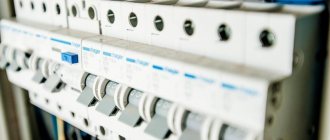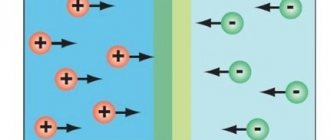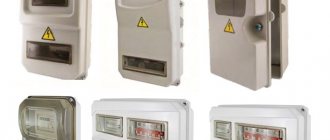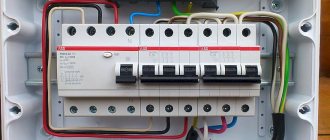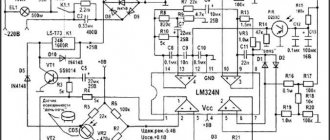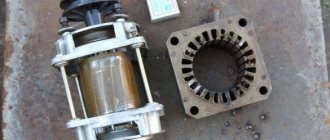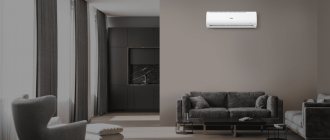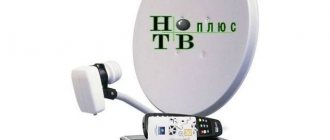What is an electrical panel
An electrical panel is a power transmission and distribution unit, which includes protection devices, metering devices and other switching and measuring devices. Each electrical panel contains one or more incoming lines and many outgoing lines.
Input electrical distribution board
In industrial and household electrics, electrical panels of 2 types are common:
- Power shield (PS). Designed to power powerful consumers in enterprises and ordinary electrical appliances plugged into an outlet at home.
- Lighting board (SHB). Used to connect lighting networks.
Separation of consumers into groups
The electrical panel has a general input circuit breaker. From it, the wires disperse to group circuit breakers, of which there are up to several dozen in a three-room apartment.
Group circuit breakers are designed to divide consumers into separate, independent circuits. For example, sockets in the living room are connected through the QF3 machine. From QF4 - bathroom. And QF5 is apartment lighting. For a private home, separate protection of lighting circuits on the street or in the garage can be performed in a similar way.
Dividing consumers into groups makes it possible to make apartment protection selective. If there is a short circuit in the living room outlet, only the electrical appliances in that room will turn off. The lighting and voltage in the sockets of other rooms will remain intact.
Electrical panel diagram
For assembly, adjustment and further operation of the switchboard, it is necessary to draw up an electrical circuit diagram (PED). According to the rules, it must be present on the inside of the electrical panel door. The diagram shows the following elements:
- types, quantity and serial numbers of protection devices and electricity meters;
- wires and how they connect and interact with each other;
- rated currents of each protective device;
- connection of grounding bars, if any.
Electrical panel diagram for an apartment
Shield body
We have already said that plastic or metal can be used in manufacturing. Each material may have its own characteristics and therefore you need to familiarize yourself with them. Many experts recommend buying plastic models, as they do not conduct electricity and have increased stability.
Metal shield for counter and machines
The models are quite stylish and can fit into almost any interior. Metal panels can have many modifications and this allows you to quickly select the desired design.
Types of electrical panels
The dimensions of the shield fundamentally depend on the number of electricity consumers that are powered by it. Standard shields in a house are usually small. Their largest side does not exceed 50-60 cm (we are talking about modern IEK type boards). Industrial shields can be as tall as a person and several meters wide.
Metal body IEK
There are also differences in terms of installation. Panels for outdoor installation are mounted on walls using dowels. They protrude from the surface by 10-20 cm. But there are also shields for internal installation. They are walled up in the walls so that only their door is outside. In both cases, the contents of the panels must be accessible to maintenance personnel. As a rule, the door is locked with a key included with the switchboard.
Price issue
The cost of creating a shield depends on the number of elements, as well as on the manufacturer and place of purchase of the products.
To estimate the cost, you can use prices taken from the catalog of one online store (current as of January 2020):
- metal hinged shield type ShchRN-60z IP30 — 3,400 rubles;
- ShchMP type shield - from 400 to 1000 rubles. (depending on size);
- plastic wall box - from 300 to 2300 rubles;
- built-in Legrand shield - from 1200 to 5400 rubles;
- circuit breaker ABB 2P C40A - 1200 rub.;
- Mercury 201 counter - about 800 rubles;
- protection device IEK 2P 63A 30 mA - 750 rub.;
- differential automatic machine Legrand DX 2P 25A 30mA - about 2000 rubles.
The minimum cost of components will be about 4-5 thousand rubles. The price of large shields can reach several tens of thousands of rubles.
Switchboard equipment
Power transmission and distribution panels perform many tasks. Protection of wiring from overcurrents, electricity metering, switching of consumers over time - this is only a small part of the functions for which panels are designed. Therefore, their contents are no less diverse.
Electricity metering devices
Present in every residential switchboard and in some substation switchgears. The meter is designed to record the amount of electricity consumed by the consumer.
A 220 V household meter has 4 contacts for wires. If you connect step by step from left to right, then their purpose is as follows:
- Lin. Input of the supply phase of the input cable.
- Lout. Phase output to consumer.
- Nin. Neutral wire input.
- Lout. Output of the neutral wire to the consumer.
To install a three-phase meter, you will need to connect 8 wires. They are connected taking into account the purpose of the device terminals, which is described in the technical documentation.
Circuit breakers
They are installed at the input in front of the meter in every household electrical panel. Not less common in industrial control panels. Circuit breakers are the most common short-circuit and overcurrent protection devices.
At the entrance to the apartment, a switchboard with 2-pole circuit breakers is installed. For individual group consumers - single-pole. There are also 3 and 4 pole devices.
The task of the machines is to de-energize the line if there is a short circuit or overload. In case of a short circuit with high currents, tens of times higher than the rating of the machine, it turns off instantly. With small overloads of 1-2 In, the machine will work after a while.
General Electric modular machines
Additional Information. The rated current and tripping current of a circuit breaker are two different things. By rated we mean the current at which the device remains switched on indefinitely. For example, for a C16 machine it is 16 A. The operating current is always greater than the rated one.
Differential circuit breakers and RCDs
They are also used in apartment panels, but are much less common. RCDs and automatic circuit breakers are usually installed in new buildings and when modernizing old electrical networks.
RCD is used to protect people from electric shock. The electronic filling of this protective device is able to understand that someone has touched a live wire and instantly turn off the dangerous potential. Fire protection RCDs are distinguished separately. They protect wiring from fire, but work on a similar principle.
The difavtomat is a combined device. It combines the functionality of a circuit breaker and a residual current device in one housing.
Voltage control relay
Belongs to the class of protection devices. The control relay protects the consumer from excessive voltage sags or surges, which can damage expensive consumer electronics. RKN is especially relevant for small cities or remote settlements, where tension can spread in an unpredictable way over a wide range.
In the electrical panel, this device is installed after the input machine and metering device. If the voltage is outside the permissible limits, it turns off the supply phase wire. The voltage control relay has an operating range setting. That is, it is possible to independently indicate at what network voltage the apartment is connected and at what it turns off.
Grounding and zero bus
Zero and grounding buses are used for ease of installation and clarity of the assembled panel diagram. The use of these elements is a requirement of the PUE. Therefore, they are provided in most modern electrical panels.
The grounding bus is connected to the building's grounding loop. In the diagram it is denoted by the Latin letters PE. And yellow-green wires are connected directly to the grounding bus in the shield. In houses with old PE wiring, the bus may be missing.
The neutral bus is electrically connected to the neutral conductor of the input cable and the neutral of the transformer substation. It is necessary for the operation of household single-phase electrical appliances. In the diagram it is indicated by the letter N. And in the shield, wires of blue or black (less often) color are connected to it.
Important! If you touch the zero bus, it will not give you an electric shock (do not check). However, when working with it, special care must be taken. If you disconnect the common neutral wire coming to it from the N bus, then a voltage of up to 380 V will flow through the apartments powered by the switchboard. At the same time, some residents are likely to burn out some of their expensive household appliances. And the blame will fall on the person who mistakenly rejected the total zero.
Comb tire
Designed for quick, simple and intuitive assembly of the electrical panel. The comb bus is essentially a jumper. It is installed in horizontal rows of circuit breakers for their simultaneous connection.
If there are 10 machines standing in a row, and each one needs to be supplied with a phase wire, then 1 comb is enough. Previously, for this you had to make special jumpers with your own hands.
RX Legrand comb tire
The comb busbar is made of copper. If desired, you can cut it yourself to the desired size or remove excess leads (teeth) with pliers. The outside of the comb is insulated with a layer of plastic, which makes it much safer than outdated jumpers.
Terminal blocks
They are found in complex devices where dozens or more elements (automatic machines, relays) are used. Terminal blocks are most common in low-current equipment. They also make the circuit easier to install and understand. With their help, it is possible to quickly disconnect or connect one or another element of the electrical panel.
Some terminal blocks are produced in assembled form. If necessary, they can be expanded as a constructor to the desired size. Therefore, they will never take up extra space in the shield.
Trays for wires
Typical for large boards with complex equipment. Trays are used for compact wiring. They are similar in design and purpose to cable ducts. The trays have a cavity for wires and a lid with a latch.
The difference between cable ducts and trays lies in the holes in the side walls. Regular cable channels do not have them. Trays have it. The holes are intended for the output and input of additional wires.
Other devices
Other equipment refers to devices that are not present in every panel. However, without them, some electrical systems cannot operate. Conventionally, these devices are divided into 5 categories:
- Switching devices (relays, magnetic starters, contactors, disconnectors). Designed for mechanical switching on and off of electrical circuits.
- Protection devices. In addition to the listed machines and RCDs, this category includes all kinds of current and voltage relays, powerful fuse links and low-current fuses.
- Frequency drives. They are installed in panels of conveyors, elevators and other equipment where it is necessary to control the rotation speed of motors.
- Indication and alarm. Various indicator lamps displayed on doors, electrical panels, sound alarms, sirens, flashing lights.
- Devices for interacting with other equipment via digital and analog communication channels. For example, RS-485 to USB interface converters, various expansion units. Needed for operation of switchboard equipment with PC programs and various portable diagnostic devices.
USB-RS485 to DIN Rail Converter
Calculation of panel dimensions and DIN rail length
With the advent of globalization, electrical equipment manufacturers were forced to standardize the dimensions of their products. All automatic devices, RCDs and modular devices have standardized dimensions.
This approach allows you to easily calculate its dimensions at the shield development stage. For example, a standard circuit breaker is 17.5 mm wide. If, according to the diagram, it is necessary to install 10 group circuit breakers at the bottom of the switchboard, then a DIN rail with a width of 175 mm (17.5x10) should be left under them.
Two-pole circuit breakers and RCDs are 2 times larger in size, equal to 35 mm. Three-pole devices have a width of 52.5 mm (17.5x3). And four-pole ones, respectively, are 70 mm.
There are also larger modular devices. Their size is also a multiple of the width of 1 module, that is, 17.5 mm. For example, electricity meters. Their width is 6-8 standard modules (105-140 mm).
Electrical panel assembly
Experienced electricians assemble electrical panels more accurately and faster than beginners. An experienced assembler is characterized by tight wiring installation, right angles and clarity of the resulting diagram. High-quality assembly requires practical and theoretical knowledge and the ability to use equipment. Therefore, it is important to understand how the switchboard is assembled.
DIN rails
DIN rails are a metal profile designed for quick and convenient installation of modular devices, usually automatic machines or RCDs. The rail is made of iron. If necessary, it can be shortened to the desired size with a grinder.
The rail is attached to the shield with self-tapping screws. Its length is selected based on the number and width of devices that need to be installed on it. However, it is better to leave some margin in size and take a DIN rail 5-10 cm larger. This solution will be useful when upgrading the shield in the future or adding new devices. For example, additional group circuit breakers.
Installation and connection of modular devices
Automatic devices, RCDs and other equipment are installed in the switchboard using DIN rails. For this purpose, a latch is provided on each of the devices in their rear part.
To install a modular device, you need to hook it onto a DIN rail. There is a special “tooth” at the top of the device. There is a latch at the bottom. The modular device is attached (hung) to the upper tooth. Then a slight hand force is applied to the lower part until a characteristic click is heard. Here it is important to understand where the mounted device is top and bottom.
A screwdriver is required for removal. With its help you need to pull back the lower tooth of the mounting ear. It can be found on the back of any modern circuit breaker.
Connecting modular devices is usually done using screw terminals. A little less often, in low-current equipment, WAGO type clamps are used, into which it is enough to insert a wire core terminated with a sleeve.
Cable entry for panel
If the switchboard is to be used in an apartment, then it is enough to insert the wires through one of its holes. It is important to ensure that the wiring insulation does not rub against the metal edges of the hole, which should be smooth and free of metal burrs.
If the operating conditions of the shield are more severe (dust, drops of water), then it is necessary to take care of the tightness of the input and output cables. For this purpose, sealed inputs are used. They come with minimal basic protection. Such bushings are cheap and protect switchboard equipment from large dust. But there are also more expensive models that can ensure complete sealing of the wire entry point and protect panel devices from direct jets of water.
Place for installing an electrical panel
Proper installation will save maintenance personnel from a lot of problems in the future. Therefore, when choosing a place for installation, you should be guided by a number of simple rules:
- The electrical panel must be accessible; its door must be easily and unhindered by qualified personnel. Helps with urgent emergency transfers or repairs.
- The shield should not be placed in places where flooding is possible. No sealed input will save the inside of the shield from a long stay under water. This also applies to dachas with spring floods.
- If the shield is not sealed, then it can only be installed in dry rooms. Rain and moisture from the air can penetrate inside and lead to corrosion.
- Avoid flammable or explosive vapors, as well as flour or wood dust. Contactors, magnetic starters and relays installed in switchboards can spark during operation. This factor can lead to fire or explosion.
Additional Information. According to the rules, a “lightning bolt” type warning sign is located on the door of the electrical panel. It is designed in the form of a pictogram with a black zigzag in a yellow triangle. For household panels, the sign is issued in the form of a sticker. Its purpose is to prevent children and untrained people from electric shock. Do not neglect the installation of this sign.
Stripping cables
If there are few wires, you can use any sharp knife, even a kitchen or stationery knife, to remove the insulation. Here it is important to cut only the insulating layer and not damage the current-carrying conductors. This skill comes with experience.
If there is a lot of wiring, then it is more rational to buy a specialized knife for cutting cables. It allows you to perform electrical installation work faster and better, with less physical effort and the risk of injury (cutting yourself).
Connecting group consumers
For clarity and convenience of connecting individual consumers, they are usually divided into groups. This approach allows you to assemble a horizontal ruler from difavtomats. Usually it is located at the bottom of the shield. Each machine is marked with a separate tag indicating its purpose. For example, “light in the living room” or “washing machine.”
Tags are written by hand on small sheets of paper or purchased at an electrical store. The second option is more convenient, since the store tag for the electrical panel has an adhesive layer and is easier to attach next to the corresponding machine. Regardless of the designation method, it is important to ensure that the indicated inscriptions are legible to other people.
What is
The standard configuration of the electrical panel is as follows:
- Electric meter;
- Differential automatic machines;
- Introductory machine;
- Circuit breakers;
- 2 tires.
Now let's take a look at the built-in elements and what they are used for:
- DIN rail. It is a special device made of metal plates. It happens that the rail is too long, in which case it is cut using a hacksaw;
- Electricity meter. Necessary to take into account electricity consumption;
- Circuit breakers. This equipment protects electrical wiring. Before installing them, you need to know what the power of the devices that will be connected to the network is;
- Distribution bus. With its help, neutral wires are connected. They are closed and open;
- RCD. Residual current device ensuring safety from electric shock;
- Electrical wiring.
Common installation mistakes
Errors during installation of the electrical panel can lead to fire or incorrect operation. To assemble an electrical panel yourself, you need to familiarize yourself with the basic requirements for installing such equipment.
- Flexible stranded wires are clamped into terminals through lugs (sleeves). This is especially true for screw connectors. When the terminal block bolt is tightly tightened, it crushes the thin wires of the wire. Therefore, they break, but outwardly the problem remains invisible.
- Before connecting the wire to the terminal block, the insulation is removed from it. The length of the stripped layer depends on the depth of the terminal block. It is necessary to check that only the bare current-carrying core without insulation gets into the clamping mechanism.
- You cannot connect wires of different cross-sections to one contact of the machine. As the screw is tightened, the thick wire will be clamped first, while the thin wire will remain unfixed. If this rule is violated with powerful consumers, sparking and heating contact is guaranteed.
- It is undesirable to use monolithic wiring in panels where mechanical vibrations are possible. Constant shaking will eventually break the current-carrying conductor. The problem is especially typical for aluminum wiring.
- The ends of wires, machines, meters and any other devices in the switchboard must be marked. It’s not a fact that in 10 years it will be you who will be servicing the shield. Therefore, it is important to sign everything so that the installers who come for repairs understand what goes where and how it works. It is also worth remembering the color coding of the wires and the diagram on the door.
Excerpt from PUE. “Combined neutral protective and neutral working conductors must have the letter designation PEN and a color designation: blue along the entire length and yellow-green stripes at the ends” (PUE-7 clause 1.1.29).
Selecting a metering cabinet
So, the box for placing metering devices should:
- contain the meter and electrical equipment necessary to perform the functions assigned to it;
- meet the requirements for protection from harmful environmental factors;
- Protect from unauthorized access;
- Ensure hermetically sealed input of supply and outgoing cables.
When choosing a box based on these criteria, let's start with the product manufacturer. All major companies producing electrical equipment also produce shield covers for various purposes. These include;
- ABB
- Viko
- Schneider Electric
- Legrand
- TDM
- IEC.
In this list, manufacturers are listed in descending order of price. Unfortunately, the last item on the list is a budget option and far from the best.
If you have the opportunity to purchase branded products in a wide range, including made-to-order, carefully read the manufacturer’s catalogs. Each of them has many nuances related, for example, to what is included in the standard delivery package of the shield and what is purchased separately.
Basically, buying a box comes down to going to the nearest shopping center, where the most popular models of panel products from various manufacturers are displayed on the shelves. Naturally, there you will see both expensive high-quality models and products of worse quality. The choice is yours.
Maintenance of electrical panels
Even a correctly assembled and approved electrical panel requires maintenance. The frequency of these measures is determined based on operating conditions, requirements for uninterrupted operation and complexity of the equipment.
The main maintenance activities for the switchboard include the following:
- visual inspection of wires under load;
- listening to the live panel for crackling or unnatural buzzing sounds;
- tightening screw connections and terminal blocks (with stress relief);
- cleaning switchboard equipment from dust and other pollutants;
- checking the presence of tags on the wires and their compliance with the electrical diagram;
- measuring the temperature of individual devices and contacts;
- control of the presence of seals on measuring instruments (in the case of commercial accounting).
Without electrical panels it is impossible to build complex electrical networks. You can’t do without them in a small one-room apartment. With their help, protection and automation devices (RCDs, current and voltage relays) are assembled compactly and in one place. Thanks to this, electricians have convenient access to key power control and distribution units.
The assembly of electrical panels begins with design, drawings and diagrams. This takes into account the dimensions of the devices included in the system. At the same stage, the location of the equipment is also considered, because high humidity and dust can damage the internal electrical devices of the panel.
Features of choosing a shield
Machine denominations
When choosing a box, you need to understand that they are divided according to the following parameters:
- What material are they made of?
- In what area are they used?
- Installation method;
- The amount of equipment placed inside.
Note! When choosing a shield, you should pay attention to such a parameter as the IP protection class. For those installed indoors, the class should be 30 or 40, for outdoors - 65 or 67.
The IP protection degree is how well the devices are insulated from dust and moisture. The higher the numbers, the higher the protection. Eg:
- IP20 – installed in apartments. 0 – no protection from moisture. 2 – provides protection from large dust particles;
- IP21-23 – installed in unheated enclosed spaces or under canopies;
- IP44 – installed outdoors, under canopies or with additional protection;
- The most protected shields are those with protection classes IP54 and IP66 - they are installed outdoors and are not afraid of exposure to rain or wind.
Note! It is convenient if cabinets installed in hallways or on the street have a viewing window that allows readings to be taken. When working with such shields, you do not have to open the door every time.
A modern shield for an electric meter is made from a variety of materials, such as:
- Plastic. Such boxes are installed inside apartments and office premises. The products themselves may differ in internal configuration, color and external design. A lock may be provided on the door. When choosing a plastic shield, you must be careful with the manufacturer's data. You should not choose products from little-known suppliers at a low cost - such boxes are made of low-quality plastic, which turns yellow over time under sunlight. Such products have both pros and cons. The main advantage is ease of installation. The shield is easily mounted in plasterboard or similar walls. Electrical panels are made from dielectric material, so they do not require additional grounding. Plastic cases are characterized by durability and visual appeal, so they harmonize in any interior. The disadvantage of the material is that it is flammable and quite fragile. If the shield installed in the wall gets damaged, it will be difficult to replace it;
- Metal. Boxes with a metal body are installed in garages and open spaces. They are strong, durable and resistant to external influences. In addition, they are not flammable and are not afraid of high temperatures. However, the disadvantage is significant: mandatory grounding is required, and the metal itself, being in an aggressive environment, corrodes. As a rule, metal boxes are installed in the entrances of apartment buildings or in enterprises.
Metal equipment
If you intend to install it outdoors, then it is better to pay attention to the anti-vandal design, for the manufacture of which sheet steel with a thickness of 1.2 mm is used. These boxes are equipped with two doors: one is blind, the second is an inspection window for the meter.
Advantages of installing a shield on the street:
- Quick access to the electric meter by the inspector;
- In some country residences, shields reach impressive sizes, so in order to save free space they are taken outside;
- If the shield does not fit into the interior of the interior, it is mounted outdoors.
Disadvantages of street placement:
- Based on the rules of the PUE, outdoor cabinets must provide local heating, which provides the meter with a positive temperature. It is not always possible to meet this condition, and induction devices simply “lie” at sub-zero temperatures;
- In order to take readings from the meter, you need to go outside, where conditions may not always be good;
- The need to re-tighten group lines.
The type of installation of the shield also varies, so they are:
- Invoices. They are installed on the surface of the walls. Allows the distribution of open and hidden wiring;
- Built-in. Mounted in niches located in the walls. Used only for hidden wiring.
Depending on how much additional equipment will be installed, you should determine the capacity of the shield. Electrical boxes have different configurations, depending on the number of seats: 12, 24, 32, 64 and more. One place has a standard distance of 17 to 18 mm. You need to be careful, as each device takes up a certain number of spaces. Experts recommend using boxes with extra space (this is especially true for built-in panels), which may be required when upgrading the electrical circuit. The minimum size of such devices is 16-24 seats.
When choosing boxing equipment, it is recommended to pay attention to the following criteria:
- Technical specifications;
- Manufacturer's reliability.
To determine the technical parameters, simple calculations will be required, but making sure that the manufacturer is reliable is not so easy. In the modern market there are inexpensive counterfeit products. In addition, you can stumble upon an outright fake of a well-known brand. Therefore, when choosing equipment, you should check the availability of the appropriate certificate, especially if we are talking about a metering device. No electricity supplier will connect uncertified equipment that has not been tested.
At the moment, many companies are engaged in the production of boxes. Based on practice, preference should be given to the following companies: ABB, IEK, Makel. If electrical installation work is required, these brands appear most often. Products from ABB are considered to be of the highest quality, and the last 2, although inferior in quality, are popular due to their affordable cost. If the main preference is the visual component and at the same time reliability, you need to choose equipment from the Greek manufacturer FOTKA.
